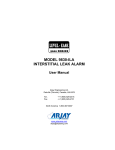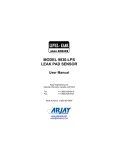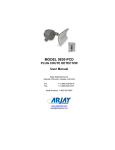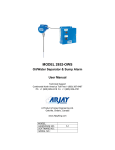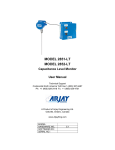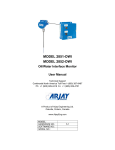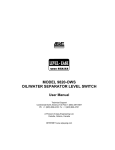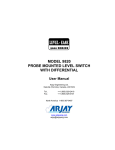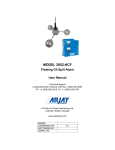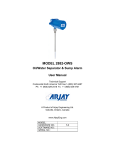Download ARJAY ENGINEERING 9830-OWS User manual
Transcript
MODEL 9830-OWS OIL/WATER INTERFACE LEVEL SWITCH User Manual Arjay Engineering Ltd. Oakville (Toronto), Canada, L6H 6C9 Tel . Fax. ++1 (905) 829-2418 ++1 (905) 829-4701 North America 1-800-387-9487 www.arjayeng.com [email protected] 9820 | 9830-OWS Oil / Water Separator Level Alarm Reliable interface monitoring of oil/water separators, sump pits and containments for pump control and alarm Over 30 years of Arjay’s field proven HF capacitance technology has been applied to the 9820/9830-OWS oil water separator alarms. The sensing probe continuously monitors for oil to control pumps, operate valves, or activate alarms. • capacitance technology does not foul or require cleaning • no moving parts • remote alarm unit mounts safely away from pipe 9820 | 9830-OWS The 9820/9830-OWS sensing probe monitors the capacitance field around the active probe tip. As the volume of separated oil increases in the separator or is drawn down toward the probe tip, the probe capacitance changes. This change is used to activate the relay for alarm interface and control. Features and Benefits Technical Specifications - Control Unit • no moving parts • remote electronics via standard twisted pair • available with Intrinsic Safety Barrier for Hazardous Locations • high corrosion resistant Teflon and stainless steel wetted parts • capacitance technology responds to all oil types • HF capacitance technology does not require routine cleaning • easy calibration and control set-up All calibration, control relays and power wiring is available at the main control unit. This can be safely mounted up to 1 km away from the sump. Operating Temperature Power Input Alarm Relay Standards Enclosure Optional -20˚C to 60˚C 24 vdc or 110 vac or 220 vac 5 amp, DPDT, dry UL, CSA Type 4X, IP65 Lights and Buzzer Technical Specifications - Sensor Process Temperature Ambient Temperature (probe head) Approval The Model 9820-OWS version provides the electronics mounted directly to the probe for economical and compact installations. -60˚C to 260˚C -60˚C to 50˚C CSA Class 1, Zone 1 and 2, Div 1 and 2, Groups A,B,C,D (also available with an Intrinsic Barrier on the 9830-OWS) ABSA-CRN #0F07450.2 The unique PMC circuit design, exclusive to Arjay, immediately converts the sensor signal to a frequency pulse for furtherance to the controller (9830 version). Arjay SS-06 Arjay Engineering Ltd. 2851 Brighton Road Oakville, Ontario Canada L6H 6C9 tel fax N. America email web ++1 905-829-2418 ++1 905-829-4701 1-800-387-9487 [email protected] www.arjayeng.com MODEL DOCUMENT TYPE DOCUMENT FILE NAME 9830-OWS USER MANUAL 9830OWSUM14.DOC 1.4 REV. CREATE DATE REV. DATE PRINT DATE 04/08/2003 12/22/2009 10:07 AM 12/22/2009 10:07:00 AM TABLE OF CONTENTS 1.0 2.0 3.0 4.0 INSTRUMENT OVERVIEW............................................................................................ 3 1.1 FEATURES ....................................................................................................... 3 1.2 DESCRIPTION .................................................................................................. 3 INSTALLATION .............................................................................................................. 6 2.1 PROBES ............................................................................................................ 6 2.2 PROBE INSTALLATION ................................................................................... 6 2.3 PULSE CARD INSTALLATION ......................................................................... 6 2.4 ELECTRICAL INSTALLATION.......................................................................... 8 STARTUP AND CALIBRATION ..................................................................................... 9 3.1 POWERUP ........................................................................................................ 9 3.2 CONTROL AND FUNCTION SWITCHES ........................................................ 9 3.2.1 Failsafe ..................................................................................................... 9 3.2.2 Alarm Time Delay ..................................................................................... 10 3.2.3 Sensitivity .................................................................................................. 10 3.2.4 Dielectric ................................................................................................... 10 3.3 CALIBRATION................................................................................................... 10 TROUBLESHOOTING ................................................................................................... 11 HARDWARE REV. SOFTWARE REV. 1.0 9820_06 and higher Page 2 of 12 MODEL DOCUMENT TYPE DOCUMENT FILE NAME 9830-OWS USER MANUAL 9830OWSUM14.DOC 1.4 CREATE DATE REV. DATE PRINT DATE 04/08/2003 12/22/2009 10:07 AM 12/22/2009 10:07:00 AM 1.0 INSTRUMENT OVERVIEW 1.1 FEATURES REV. Push-button calibration RF Technology Double pole Double Throw (DPDT) 5A relay contacts 0 – 20 second time delay Adjustable sensitivity High or Low relay action No moving parts For use with any Arjay Level Probes 1.2 DESCRIPTION The ARJAY 9830-ows oil level alarm is specifically designed for use in Oil/Water Separators and in Sumps. The unit senses the change in dielectric of water to oil using a RF capacitance measurement technique together with microcontroller technology for high resolution measurements. The ARJAY sensing probe is inserted into the vessel and a signal is sent to the remote controller. The ARJAY oil level alarm will activate a relay contact when the predetermined level of oil is reached. There are two main applications for the 9830-OWS. The Oil/Water Separator must be of the type that is permanently filled with water. The water is gradually displaced from the vessel as the oil is introduced. The active sensing portion of probe is mounted below the oil pump suction and when the interface of oil reaches this active portion the 9830 alarms indicating the need to pump out the oil. The Sumps normally have a pump with the suction on the bottom. The liquid level of the Sump is maintained above the active portion of the probe using a separate level device (e.g. Float). The 9830OWS is used to sense an interface of oil before it is pump out of the Sump to the sewer. The 9830OWS will also alarm if there is not sufficient liquid within the sump thus acting as a dry pump monitor. HARDWARE REV. SOFTWARE REV. 1.0 9820_06 and higher Page 3 of 12 MODEL DOCUMENT TYPE DOCUMENT FILE NAME 9830-OWS USER MANUAL 9830OWSUM14.DOC 1.4 CREATE DATE REV. DATE PRINT DATE 04/08/2003 12/22/2009 10:07 AM 12/22/2009 10:07:00 AM 9830-OWS OIL / WATER SEPARATOR APPLICATION 2 WIRE (SHIELDED) INTRINSIC SAFETY BARRIER (OPTIONAL) 9830-OWS Manway Arjay Level Probe Earth Line Oil Pump Overflow Liquid Level Sensing portion of probe is below pump suction OIL WATER SEPARATOR 9830 OWS BLOCK.DSF Figure 1.0 9830-OWS SUMP APPLICATION 2 WIRE (SHIELDED) INTRINSIC SAFETY BARRIER (OPTIONAL) 9830-OWS To sewer Maintained water level Float switch Sensing portion of probe is above pump suction and below water level Sump Pump 9830 OWS BLOCK.DSF Figure 1.1 HARDWARE REV. SOFTWARE REV. 1.0 9820_06 and higher Page 4 of 12 REV. MODEL DOCUMENT TYPE DOCUMENT FILE NAME 9830-OWS USER MANUAL 9830OWSUM14.DOC 1.4 REV. CREATE DATE REV. DATE PRINT DATE 04/08/2003 12/22/2009 10:07 AM 12/22/2009 10:07:00 AM OPERATION The unit uses an RF Capacitance measurement technique for high resolution measurements. When the presence of oil displaces the water the level probe senses the decrease in capacitance and the control unit will indicate an alarm condition and change the state of it’s dry relay contacts. USER INTERFACE Instrument status Alarm Status Time delay Relay action Dielectric switch 2 color indicator: Green for normal operation, Red = instrument error, Red/Green (orange) for calibration confirmation. Red indicator: On when not in alarm, Off when in alarm. 0 – 20 seconds. High or Low relay action. For high action, the relay is de-energized under normal conditions and energizes when there is a presence of oil. For low action, the relay is energized under normal conditions and de-energizes when there is a presence of oil. Primarily used in high dielectric where there is a presence of water at time of calibration. PERFORMANCE Resolution The unit measures capacitance in pF. Capacitance to Level translation depends on the surroundings and the type of material being measured. Capacitance: 0.4% of measured capacitance. Example: at 50pF, the resolution is 0.2pF and at 100pF, the resolution is 0.4pF. SENSOR CONNECTION 2 wire + shielded cable from PMC 2000 to controller. RELAY CONTACTS Failsafe. DPDT 5A (resistive load) /250VAC/30VDC dry contacts. Selectable high or low acting alarm. POWER 115VAC or 220VAC @ 25mA max. 24VDC @ 60mA max. MECHANICAL SPECIFICATIONS Enclosure Standard: Nema 4x Dimensions /Weight 10” (254mm) x 8” (203.2mm) x 4” (101.6mm)depth / 4lbs. (1.81kg) ENVIRONMENTAL SPECIFICATIONS Operating Temp. -20 to 60°C for Controller only. For remote probe:-40 to 80°C Relative Humidity 90% max. with no condensation. HARDWARE REV. SOFTWARE REV. 1.0 9820_06 and higher Page 5 of 12 MODEL DOCUMENT TYPE DOCUMENT FILE NAME 9830-OWS USER MANUAL 9830OWSUM14.DOC 1.4 CREATE DATE REV. DATE PRINT DATE 04/08/2003 12/22/2009 10:07 AM 12/22/2009 10:07:00 AM 2.0 REV. INSTALLATION NOTE: If any damage to the instrument is found, please notify an Arjay Engineering representative as soon as possible prior to installation. Choose the mounting location in accordance with good instrument practice. Extremes of ambient temperature and vibration should be avoided. 2.1 PROBES Capacitance probes may be ordered at different lengths depending on the size and location of each oil/water separator or sump. Most OWS probes are Teflon coated with an inactive 316ss sheath covering the entire length of the probe with the exception of the last 4 inches. The length of the probe is specified by the customer and is determined by the height of oil interface that the customer wants be alarmed at. The exposed white Teflon portion of the probe tip is the active sensing portion so the alarm point has to be within this 4” section. 2.2 PROBE INSTALLATION Standard probe entry into a tank is via a 3/4" NPT opening (standard probes) or 1" NPT opening (heavy duty probes). Flanges and concentric shields are available as options. The entrance configuration may vary depending on the application requirements. USE WRENCH ON LOWER HEX . The probe fittings are compression type with Teflon ferrules assembled by applying torque between the two hex sections. The fittings are sealed at the factory to provide a compression seal capable of withstanding high pressures. Once the fittings are opened they cannot be reassembled without replacing the ferrules. 2.3 PULSE CARD INSTALLATION Check that the pulse module circuit (PMC-2000) is installed into the probe head according to the installation drawing. Both circuit mounting screws are required to insure a good electrical ground. Check that the blue probe lead is secured to the PMC circuit terminal marked "P". (If coax cable is used from the probe to the junction box then connect the center wire of the coax to “P” and the braided coax shield to the ground screw in the junction box). Wire the circuit card to the main control unit using two-wire shielded instrument cable 16-18awg (EG.BELDON 8760). DO NOT run these wires along side of high voltage wires. Connect the + & terminals on the pulse card to the probe terminals marked + & - at the controller. Connect the shield of the cable to the ‘S‘ terminal at the controller side only. Make sure that the PMC junction box is electrically grounded. CAUTION: INSTALL PROBE WITH CARE: DAMAGE TO TEFLON SHEATH WILL CAUSE MEASUREMENT ERRORS. HARDWARE REV. SOFTWARE REV. 1.0 9820_06 and higher Page 6 of 12 MODEL DOCUMENT TYPE DOCUMENT FILE NAME 9830-OWS USER MANUAL 9830OWSUM14.DOC 1.4 CREATE DATE REV. DATE PRINT DATE 04/08/2003 12/22/2009 10:07 AM 12/22/2009 10:07:00 AM THREADED ENTRY FLANGED ENTRY CONCENTRIC SHIELD ENTRY Use wrench on Lower Hex ONLY 2" Entry Typical 1- For threaded and flanged entry types, measurement sensitivity is increased by reducing the probe to wall distance. 2- There should be good electrical conductivity between the tank wall and the transmitter enclosure. (For probes with a concentric shield this is not important). INSTALL PROBE WITH CARE: IF TEFLON COATING IS DAMAGED, THE PROBE WILL NOT WORK PROBE INSTALLATION PROBE.DSF Figure 2.0 HARDWARE REV. SOFTWARE REV. 1.0 9820_06 and higher REV. Page 7 of 12 MODEL DOCUMENT TYPE DOCUMENT FILE NAME 9830-OWS USER MANUAL 9830OWSUM14.DOC 1.4 CREATE DATE REV. DATE PRINT DATE 04/08/2003 12/22/2009 10:07 AM 12/22/2009 10:07:00 AM 2.4 REV. ELECTRICAL INSTALLATION ALARM STATUS Single DPDT relay with dry contacts rated at 5A @ 250VAC or 30VDC for resistive loads. DPDT RELAY NO C CALIBRATE NC DIELECTRIC LOW HIGH NO C SENSITIVITY GND ALARM DELAY L2 (-) RELAY L1 (+) LOW HIGH PROBE IN + 9830 CIRCUIT BOARD Some components omitted for clarity Shield Probe + Probe - MODEL 9820/30 DIFFERENTIAL LEVEL SWITCH PROBE WIRING To remote Arjay junction box with PMC 2000 card Terminals marked + and - are for DC power units. POWER NC POWER: 115VAC power is standard. For 220VAC, 24VDC units power must be stated at time of order. For DC power units, the L1 terminal is to be connected to the positive supply, and the L2 terminal for the negative supply. ELEC9830.DSF ELECTRICAL INSTALLATION Figure 2.1 NOTE: 115VAC power is standard. Other power supply voltages are supported (220VAC. 24VDC ) and must be specified at time of order. APPLYING POWER THAN THAT MEANT FOR THE UNIT MAY CAUSE DAMAGE AND OR INJURY. HARDWARE REV. SOFTWARE REV. 1.0 9820_06 and higher Page 8 of 12 MODEL DOCUMENT TYPE DOCUMENT FILE NAME 9830-OWS USER MANUAL 9830OWSUM14.DOC 1.4 CREATE DATE REV. DATE PRINT DATE 04/08/2003 12/22/2009 10:07 AM 12/22/2009 10:07:00 AM 3.0 REV. STARTUP AND CALIBRATION ALARM STATUS Calibrate Pushbutton CALIBRATE DIELECTRIC Normally set for HIGH HIGH 6 5 4 Normally set for 3 6 5 4 8 7 ALARM DELAY 9 0 1 2 3 8 7 SENSITIVITY 9 0 1 2 3 LOW Sets Failsafe of relay contacts RELAY LOW Alarm delay: 0 - 20sec. Each switch inc. = 2sec except 6=15 and 7=20. 8&9 not used = 0sec. HIGH PROBE IN + MODEL 9820/30 DIFFERENTIAL LEVEL SWITCH USER INTERFACE USERINT.DSF Figure 3.0 3.1 POWERUP After the unit has been installed as per the installation procedure in section 2, power up the unit. The Status indicator should be Green. The red Alarm indicator may be on or off and is not valid until a successful calibration has been done. If the Status indicator is red refer to the troubleshooting procedure in section 4.0 for details. 3.2 CONTROL AND FUNCTION SWITCHES Set up the control and function switches as follows: 3.2.1 Failsafe Put the selector in the "LO FAILSAFE" position. This will keep the relay energized during normal conditions. On alarm; the relay will de-energize. A power failure will also cause the relay to deenergize, signalling an alarm condition. HARDWARE REV. SOFTWARE REV. 1.0 9820_06 and higher Page 9 of 12 MODEL DOCUMENT TYPE DOCUMENT FILE NAME 9830-OWS USER MANUAL 9830OWSUM14.DOC 1.4 CREATE DATE REV. DATE PRINT DATE 04/08/2003 12/22/2009 10:07 AM 12/22/2009 10:07:00 AM 3.2.2 REV. Alarm Time Delay This is set via the Alarm Delay switch. An alarm based on the Relay Action switch must be present for at least the time delay value for the relay to switch to the alarm state. There is no delay when switching off the alarm. The delay range is 0 – 20 seconds. DELAY SWITCH SETTING TIME DELAY 0 0 seconds 1 2 seconds 2 4 seconds 3 6 seconds 4 8 seconds 5 10 seconds 6 15 seconds 7 20 seconds 8&9 Not used and act as 0 seconds. False alarms from disturbances can therefore be ignored. Position 8 & 9 are not used and are the equivalent to 0 seconds. 3.2.3 Sensitivity This selector switch determines the amount of oil level change required to cause an alarm. The switch has a "0" to "7" range with "0" being most sensitive. "3" is used for most OWS applications. If unit still has false alarms adjust the sensivity to the next number up. Position 8 & 9 are not used and are the equivalent to 0 sensitivity. **INCREASING THE NUMBER WILL DECREASE SENSITIVITY** 3.2.4 Dielectric The OWS probe should be calibrated with the probe submersed in water. The switch should be set to "HI" for this calibration. 3.3 CALIBRATION With the unit wired as per the drawing #990251, power on the unit. The status LED should be green indicating that power is on and unit is getting no fault conditions. If the status led is red then unit is showing a fault. Check to make sure unit is properly wired to the pulse card. A wiring fault or pulse card failure will cause the status LED to be red. Check the wiring for continuity and proper polarity. To calibrate for OWS applications, verify the following function switch positions: "TIME DELAY "SENS" "FAILSAFE" "DIELECTRIC" Position "6” (15 seconds) Position "3" Lo failsafe Hi dielectric HARDWARE REV. SOFTWARE REV. 1.0 9820_06 and higher Page 10 of 12 MODEL DOCUMENT TYPE DOCUMENT FILE NAME 9830-OWS USER MANUAL 9830OWSUM14.DOC 1.4 REV. CREATE DATE REV. DATE PRINT DATE 04/08/2003 12/22/2009 10:07 AM 12/22/2009 10:07:00 AM Make sure the Oil/water Separator is filled with water to capacity or the Sump level above the active portion of the probe. With the active sensing portion of the probe submerged in water, push the CALIBRATE BUTTON. The status LED will turn red momentarily. Release the button. The status led should be green and flashing on and off showing that it is in calibration mode. Push the calibration button one more time until it goes red. Release the button. Calibration is complete and status LED should be green and alarm status LED red showing that the relay is energized under normal conditions. The unit is now calibrated and will alarm when the sensing portion of the probe tip is exposed to about 2” of oil. THIS COMPLETES THE SETUP AND CALIBRATION PROCEDURE FOR THE 9830 OWS 4.0 TROUBLESHOOTING **Under normal conditions the status light on 9830 electronics (inside enclosure) should be Green and relay light should be Red. ** CONDITION 1. No indicators on at powerup DO THIS 2. Status indicator is RED (Fault Condition) Check power to unit Make sure power applied is as specified for the unit. (e.g. 120VAC) If power is ok, check the fuse. If the fuse is blown, call an Arjay representative to analyze why the fuse has blown. Make sure there is a PMC 2000 card mounted in the remote junction box. This indicates that the controller is not receiving a signal from pulse card (PMC 2000) and is weak, unstable, out of legal range, or is not present. Verify that the polarity of the two wire shielded connection is correct such that “+” at controller to “+” at pulse card (PMC 2000) and “-“ at controller to “-“ at pulse card (PMC 2000). Measure with DC volt meter across “+” and “-“ at pulse card (PMC 2000), it should read positive 9-10 Volts when plugged in. Make sure there is no break in the wiring between controller and PMC 2000 card. Disconnect probe (sensor) from “p” terminal of pulse card (PMC 2000). Verify if status LED goes to Green. Replace the PMC 2000 card with a spare if available. HARDWARE REV. SOFTWARE REV. 1.0 9820_06 and higher Page 11 of 12 MODEL DOCUMENT TYPE DOCUMENT FILE NAME 9830-OWS USER MANUAL 9830OWSUM14.DOC 1.4 CREATE DATE REV. DATE PRINT DATE 04/08/2003 12/22/2009 10:07 AM 12/22/2009 10:07:00 AM 3. False alarms REV. Add some time delay to unit. If coax cable is used from sensors to pulse card (PMC 2000), make sure it is not coiled (may cause an increase in inductance). Make sure there is no outside interference that may be causing false alarms such as an agitator, high voltage interference, or input flow to the tank affecting the probe. Adjust the sensitivity switch to next setting to decrease the 9830’s sensitivity. Test sensor after the setting has been increased to make sure the sensor can still reliably sense the presence of liquid. Make sure separator or grease trap is filled up with water above the white Teflon (sensing area) of probe. HARDWARE REV. SOFTWARE REV. 1.0 9820_06 and higher Page 12 of 12















